Gantt chart and Scheduling techniques
Contents |
Abstract
According to the Businessdictionary scheduling is about "determining when an activity should start or end, depending on its (1) duration, (2) predecessor activity (or activities), (3) predecessor relationships, (4) resource availability, and (5) target completion date of the project." [1]
In this article, a review of scheduling techniques Gantt chart and Critical path method (CPM) will be presented. The Gantt chart is one of the oldest scheduling tools and is a graphical way to explain and display the schedule-related information. The tool displays each activity and the duration, and clarify what should have been achieved at a certain point in the time. [2] The limitations with the Gantt chart is that the tool does not show the critical activities, which the Critical path method (CPM) does. The CPM is an algorithm for scheduling a set of project activities in the project. In the CPM a Network diagram needs to be developed. The Network diagram is about identifying the component activities and their relation to each other. [3]
This article will provide a step-by-step guide on how to create and use the mentioned scheduling techniques. Furthermore, this article will explain how the different scheduling techniques can supplement each other, and what the limitations in each scheduling tool are.
Project Time Management
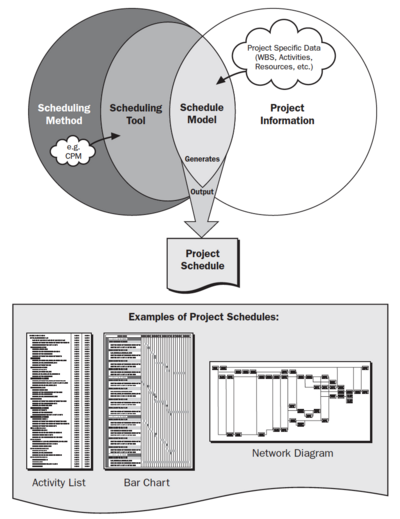
Project Time Management provides the processes that are required in a project with a timely completion. The Project Time Management includes six processes which are described below [4]:
1. Define Activities - Identify the activities and actions to be performed to produce the deliverables of the project.
2. Sequence Activities - Identify and document the connections between the activities in the project.
3. Estimate Activity Resources - Estimate the amounts and types of the material, people, equipment, or supplies needed to perform the activities in the project.
4. Estimate Activity Durations - Approximate the number of work periods required to perform individual activities with the expected resources.
5. Develop Schedule - Analyse the activity durations, sequences, resource requirements, and schedule restrictions to produce the project schedule.
6. Control Schedule - Control the status of the project to update project development and managing the changes in the project schedule.
SchedulingA plan can only show the practicability of accomplishing its objectives when the actions and activities in the plan are put together in a schedule that illustrates when each action or activity will be carried out.
|
The Gantt Chart
The Gantt Chart is the oldest form of a formal scheduling tool. The Gantt Chart was developed in the 1910s by Henry Gantt, and today used widely as a scheduling tool in projects. A Gantt chart keeps track of the progress of the multiple activities there often is in a project. [5]
Definition"A graphic display of schedule-related information. In the typical bar chart, schedule activities or work breakdown structure components are listed down the left side of the chart, dates are shown across the top, and activity durations are shown as date-placed horizontal bars.". [4] |
Gantt charts are especially useful in one-time scheduling projects. For example projects like building construction or making films are both projects that are one-time projects. Overall, the advantages of the Gantt Chart can be realised in all types of projects and organisations.
How to create a Gantt Chart?
Developing a Gantt Chart takes some steps. In the scoping phase determines the level of details and the activities identifies in the project.[6] There are many ways to create a Gantt Chart, and in the end, it depends on the project and the working style. In the table below some general steps to developing a Gantt Chart are described.
| Creating a Gantt Chart step by step | |||||
|---|---|---|---|---|---|
|
Step 1 - Creating the axes: Create a sheet with vertical and horizontal axes. The vertical axis represents the activities, and the horizontal axis represents the timescale. To make the Gantt Chart more clear and get and an idea of the total time that needs for each activity, adding the calendar time in timescale is a good idea, see figure 1. [6]
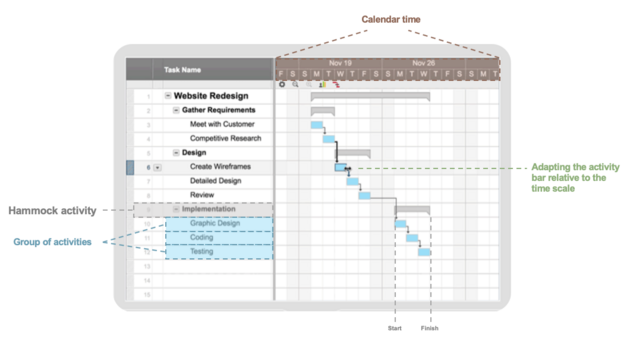 Figure 2: How to create a Gantt Chart. Reproduced from: "Smartsheet" [2]
| |||||
Critical Path Method (CPM)
The Critical Path Method was developed in the 1950s by Morgan R. Walker and James E. Kelley. CPM is very similar to PERT (Program evaluation and review techniques), but represent information differently. The CPM technique translates the project's critical tasks into a mathematical system and enables to calculate the time and resources needed to complete a project.
Definition"A schedule network analysis technique used to determine the amount of scheduling flexibility (the amount of float) on various logical network paths in the project schedule network, and to determine the minimum total project duration. Early start and finish dates are calculated by means of a forward pass, using a specified start date. Late start and finish dates are calculated by means of a backward pass, starting from a specified completion date, which sometimes is the project early finish date determined during the forward pass calculation.” [4] |
How to create the Critical path
| Creating the Critical path step by step | ||||||||||||||
|---|---|---|---|---|---|---|---|---|---|---|---|---|---|---|
|
Step 1 - Defining each activity: All activities need to be specified. The activities are usually drawn from the work breakdown structure.
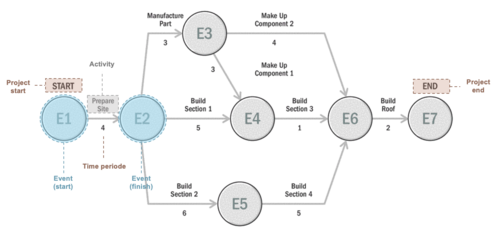 Figure 3: Arrow diagram. Reproduced from "CPM Scheduling for Construction - Best Practices and Guidelines" [8]
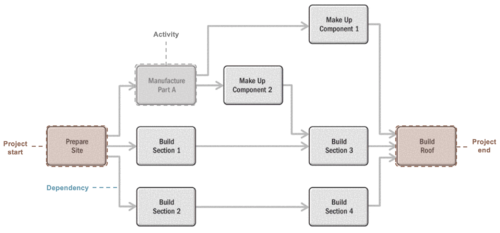 Figure 4: Precedence diagram. Reproduced from: [8] 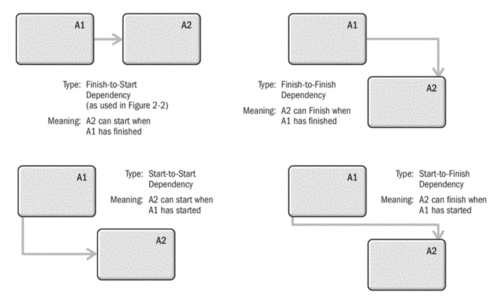 Figure 5: Dependency types. Received from "CPM Scheduling for Construction - Best Practices and Guidelines" [8]
Step 4 - Estimating activity durations and resources: Here is the duration of each activity estimated, and listed on the network diagram. There exist different time estimation methods in network-based project management, and it is up to the individual which method is used.
| ||||||||||||||
Event types and activity
Each activity in the project may have a set of properties which in the end effects the network whether the network is represented by an arrow or perceived diagram. These properties are offend called types and are:
- Dummy activities
- Hammock activities
For arrow network only, is there also types like:
- Ladder activities
- All event types
For precedence networks only:
- Start activities
- End activities [8]
Dummy activities
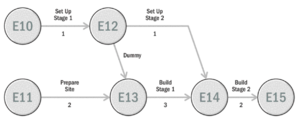
A dummy activity is not an actual task, but a logical link between the networks paths. A broken line or arrow normally indicate dummy activities. Dummy activities can be used to avoid double activities, reduce the number of dependencies and to provide a common start and finish date. Dummy activities normally have zero duration since they only represent the logical link between the networks paths and not a task. Some dummy activities do though. For example in a building project where you have wait for the concrete to cures. The time here is important in the network, and you have to indicate the duration of these activities. Such activities are called real dummies. [7] [8]
Ladder activities
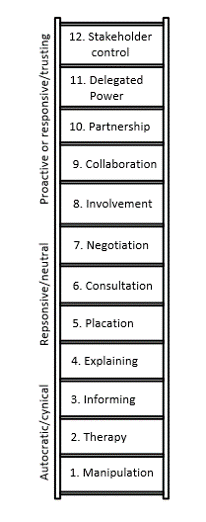
In CPM overlapping cannot be modelled in an adequate way. In network diagram overlapping cannot be modelled in an adequate way. Therefore ladder diagrams can be used to get the same early start and finish times as they can in a Gantt chart. Because the ladder diagrams cannot be interpreted in the same way as a network diagram, as they are not entirely consistent with the traditional arrow diagrams, these diagrams should be made beside the network diagram. [7]
The Importance of the Gantt Chart and the Critical Path for Project Management
How to connect Gantt chart and CPM
The Gannt chart is useful when showing the dependencies. It is easy to produce, and update, and generally is a useful "all-around project planning" tool. For more complex, time-critical projects, the CPM is a useful tool that provides a clear indication of the critical sequences of tasks essential to keeping the project on schedule. [7]
Pros and cons
| Pros | Cons | |
|---|---|---|
| Gantt chart [8] |
|
|
| CPM [7] |
|
|
Annotated Bibliography
Carson, Christopher Oakander, Peter Relyea, Craig. (2014). CPM Scheduling for Construction - Best Practices and Guidelines. Project Management Institute, Inc. (PMI)
Describes into detail the process of schedule design. The book is an excellent structured and has guidelines of how to construct, for example, Gantt Chart and CPM.
Guide, A. (2008). Project management body of knowledge (pmbok® guide). In the Project Management Institute.
A good basis for understanding the different terms and tools in project management.
Hajdu, M. (1997). Network Scheduling Techniques for Construction Project Management. Springer US.
Even so, the book is from 1997, it gives a good and detailed overview of the steps of CPM. If you want a more detailed description of the eight steps on how to create the CPM.
Milosevic, D. Z., & Martinelli, R. J. (2016). Project management toolbox: tools and techniques for the practicing project manager. John Wiley & Sons.
Provides a step-by-step guide of when and how to construct a Gantt chart, it also provides real-world examples.
References
- ↑ Businessdictionary. (n.d.). What is scheduling? definition and meaning. Retrieved February 25, 2019, from http://www.businessdictionary.com/definition/scheduling.html
- ↑ 2.0 2.1 Managing Successful Projects with PRINCE2. (2017). Managing Successful Projects With Prince2. The Stationery Office Ltd. Retrieved from https://ebookcentral-proquest-com.proxy.findit.dtu.dk/lib/DTUDK/detail.action?docID=4863041
- ↑ Kelley Jr, J. E., & Walker, M. R. (1959, December). Critical-path planning and scheduling. In Papers presented at the December 1-3, 1959, eastern joint IRE-AIEE-ACM computer conference (pp. 160-173). ACM.
- ↑ 4.0 4.1 4.2 4.3 4.4 Guide, A. (2008). Project management body of knowledge (pmbok® guide). In Project Management Institute. Retrieved from http://dreladly.com/a/File1BOK.pdf
- ↑ 5.0 5.1 DuBrin, A. J. (2011). Essentials of management. Cengage Learning.
- ↑ 6.0 6.1 6.2 6.3 Dragan Z. Milosevic, 2003, Project Management ToolBox: Tools and Techniques for the Practicing Project Manager [Available online]
- ↑ 7.0 7.1 7.2 7.3 7.4 7.5 7.6 7.7 7.8 Hajdu, M. (1997). Network Scheduling Techniques for Construction Project Management. Springer US. Retrieved from https://link-springer-com.proxy.findit.dtu.dk/content/pdf/10.1007%2F978-1-4757-5951-8.pdf
- ↑ 8.00 8.01 8.02 8.03 8.04 8.05 8.06 8.07 8.08 8.09 8.10 Carson, Christopher Oakander, Peter Relyea, Craig. (2014). CPM Scheduling for Construction - Best Practices and Guidelines. Project Management Institute, Inc. (PMI). Retrieved from https://app.knovel.com/hotlink/toc/id:kpCPMSCBP1/cpm-scheduling-construction/cpm-scheduling-construction
- ↑ Anderson, E. B., & Hales, R. S. (1986). Critical path method applied to research project planning: Fire Economics Evaluation System (FEES). Gen. Tech. Rep. PSW-93. Berkeley, Calif.: Pacific Southwest Research Station, Forest Service, US Department of Agriculture. 12 p, 93. Retrieved from https://www.fs.fed.us/psw/publications/documents/psw_gtr093/psw_gtr093.pdf